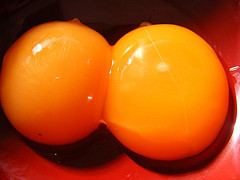
flic.kr/p/8ipr88
There are actually two meanings to the word “lecithin.” Commercially, the structure of lecithin consists of a mixture of neural and polar lipids that act as lubricants and/or emulsifiers. In biochemistry, it refers to phosphatidylcholine, a phospholipid composed of two fatty acids, glycerol, a phosphate group and choline. Lecithin was first discovered in 1846 when Maurice Gobley, a French scientist, separated the nutrient from egg yolk. He gave it the name lekithos, in 1850, which is Greek for “egg yolk.” But by the 1930s, majority of the lecithin sold commercially was taken from soybean oil. The nutrient was discovered as a by product of the degumming process of soybean oils. The Structure of Lecithin: Egg Yolk
There are differences in the structure of lecithin drawn from egg yolk and those derived from plants, such as soy lecithin. First, the structure of lecithin derived from egg yolk is essentially composed of phospholipids and triglycerides, which differs considerably from plant lipid mixtures. Egg yolk lecithin contains long chain polyunsaturated fatty acids known as Docosahexaenoic Acid and LC-PUFAs or Arachidonic Acid. Both are bound phospholipids, the latter occurring exclusively in cell membranes while the former is found in high amounts in optic nerve membranes. In the structure of lecithin taken from egg yolk, arachidonic acid is involved in signal transduction and ensures high membrane fluidity. It is vital for body weight development. On the other hand, docosahexaenoic acid is required for normal development of the brain, visual acuity and nervous system.
Consequently, both these essential components of the structure of lecithin play a vital role during pregnancy and infancy. Since babies have only limited capacities, they need docosahexaenoic acid and arachidonic acid to synthesize fatty acids from their precursors. Structure of Lecithin: Soy Markedly different from egg yolk lecithin, the structure of lecithin derived from soy actually consists of three kinds of phospholipids: phosphatidylcholine (PC), phosphatidylethanolamine (PE), and phosphatidylinositol (PI). Since soy lecithin is obtained in the process of degumming crude soy oil, it contains minimal amounts of hydratable compounds (1.8%), comprised mainly of phosphatides. After going through the synthesizing method, the resulting structure of lecithin is 30-35% crude soy oil and 65-70% phosphatides. Oil can then also be removed entirely with the addition of acetone.
In the structure of lecithin derived from soy, the phosphatides consists of glycerides, which are the primary components of soy oil. However, rather than one fatty acid radical, this has been replaced with phosphoric acid. Now, this is different in the case of chemical or pure lecithin or phosphatidylcholine, where the phosphoric acid is further esterified with choline. However, commercially, the structure of lecithin is mostly fatty acids, with roughly the same proportion as that of soy oil, which is 50-57% linoleic acid and 5% linolenic.
There are various types of lecithin derived from soy: unrefined or natural (including bleach varieties), refined, and chemically modified. All of these have different chemical compositions and structures. For example, unrefined lecithin contains 17.5% phosphatidylcholine, 15% phosphatidylethanolamine, 10% phosphatidylinositol, 14-18% other phospholipids, 31-34% unrefined soy oil, 13-16% glycolipids, and 2-4% neutral lipids (mostly triglycerides).
Tagged with: lecithin benefits • lecithin from soya
Filed under: Lecithin